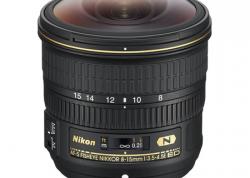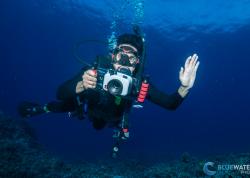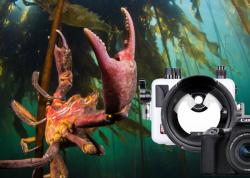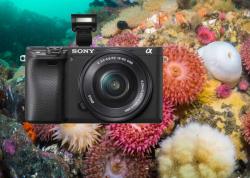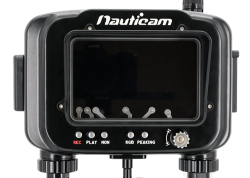Canon EOS R3: Initial Thoughts & Review
A year after the Canon EOS R5 was debuted as Canon's best camera ever created, the Canon EOS R3 was announced in September of 2021. As a direct response to the groundbreaking Sony A1, the Canon EOS R3 was designed for insanely fast burst shooting speeds of 30 frames per second with a 24.1 MP BSI stacked sensor. Due to high electronic sensor readout speeds, the R3 has the most reduced rolling shutter of any Canon camera to date. This makes the camera a great tool for video, with 6K/60p recording and 4K/120p recording in RAW, uncropped. Despite Canon eluding to a Canon EOS R1 on the horizon, the R3 is ultimately Canon's current "flagship" model. However, it might not be the best tool for underwater shooters. This is because the integrated battery grip makes this camera body a monster; it requires large, and undoubtedly more expensive, underwater housings. But a fast electronic readout does unlock some pretty useful features for underwater shooters, so let's get into why you might want to consider the Canon EOS R3 as being a great tool for underwater photo and video.
U.S. MSRP Canon EOS R3: $5999
Availability: Late November, 2021
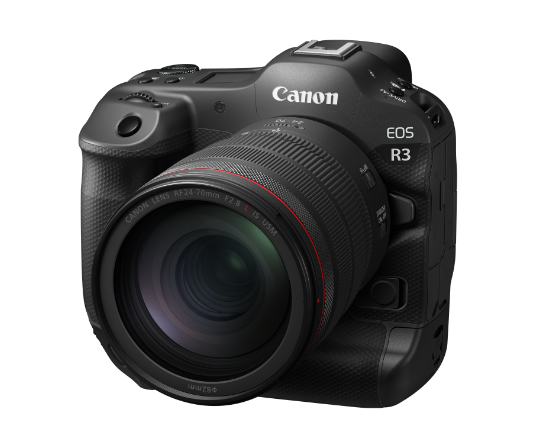
Jump to Section:
Canon EOS R3 Specs | Canon EOS R3 vs EOS R5 vs Sony A1 | Key Features
Canon EOS R3 for underwater photo & video | Best Lenses | Underwater Housings
Purchase a Canon EOS R3 underwater housing at Bluewater Photo:
Nauticam Canon EOS R3 Underwater Housing
Canon EOS R3 Camera Specifications
- 24.1 MP BSI Stacked Full-Frame Sensor
- Much faster sensor readout speed for reduced rolling shutter
- ISO Range: 100-102400
- DIGIC X Image Processor
- 30 fps burst shooting with electronic (silent) shutter and 12 fps with the mechanical shutter
- Dual Pixel AF with 1,053 AF points
- Animal eye, face, head, eye, and vehicle autofocus tracking
- Extreme low light autofocus down to -7.5 EV
- Eye control autofocus
- 5.76 million dot EVF with 120fps refresh rate - blackout free
- 6K/60p & 4K/120p video recording (uncropped)
- 10-bit 4:2:2 RAW recording internally
- 5-axis IBIS (in-body image-stabilization) with up to 8 stops of correction
- Dual CFexpress type B and UHS-II SD card slots
- Multi-function shoe
- Dust and drip resistant
- RF lens mount
- 1/200 mechanical flash sync speed, 1/180 electronic shutter flash sync speed
- Body overheats after about 60 minutes of 6K/60p shooting and 12 minutes of 4K/120p shooting
- Dimensions: 5.91" X 5.61" X 3.43"
- Weight: 2.24 lbs
Canon EOS R3 vs Canon EOS R5
The Canon EOS R3 is more similar to the Canon 1DX Mark III than the Canon EOS R5. This camera is designed for professional sports photographers and dedicated video shooters. The R3 is equipped with a lower resolution 24.1 megapixel vs the high resolution, 45 MP sensor in the R5. Theoretically, this sensor should perform slightly better in low light situations with less noise at higher resolutions than on the R5. However, the R3 is a worse choice for macro photographers who may need the R5's high resolution for cropping in post.
When it comes to autofocus, the R5 is currently the top Canon camera. However, we are excited to see how the AF is improved in the R3. In low light situations, the R3 will surely acquire AF quicker. While the novel eye control autofocus feature that allows photographers to move autofocus with their eye will be an interesting feature, we don't expect it to be useful for underwater shooters as divers need to look through the viewfinder using a mask.
The Canon R3 should theoretically be able to shoot photos with a faster electronic sensor readout than the R5 - reducing rolling shutter. This feature will be useful for both photo & video shooters, especially those looking to shoot fast subjects. It might be possible that the electronic shutter on the R3 will be able to sync with strobes which is not a feature available on the R5.
For underwater video, the R3 and R5 perform similarly with a few minor differences. The Canon R5 is capable of taking 8K high resolution video that is great for crops - especially if you are a macro video shooter. The Canon R3 is limited to 6K, but you can shoot at 60fps which is quite useful for stabilization. 6K/60p video can be captured for about 1 hour before overheating, while the Canon R5 overheats after about 20 minutes @ 8K. That being said, 4K/120p recording overheats the R3 after 12 minutes, which may be even quicker than the R5. The R3 is ultimately the more compelling camera for underwater video, as stabilization is the most important aspect of shooting in a 3D underwater environment.
But perhaps the most important difference between the R5 and R3 is size. The Canon EOS R3 is significantly larger than the Canon EOS R5 with an integrated battery grip. While this may not be a problem for topside shooters, underwater photo & video shooters will find this cumbersome as underwater housing manufacturers would need to make larger underwater housings. In fact, many manufacturers may choose not to make R3 housings altogether.
Canon EOS R3 vs Sony A1
The Canon EOS R3 appears to be Canon's answer to the Sony A1, especially in Canon's improvements to their electronic shutter and sensor readout speed. Both cameras can shoot amazingly fast burst speeds of up to 30fps RAW photos. Both cameras feature stacked sensors that perform really well in low light. However, the Sony A1 is equipped with a high resolution 50 MP sensor, whereas the Canon R3's sensor is 24 MP. The Sony A1 is thus a more appealing camera for macro photo and video shooters. The Canon R3 will still suffice, but it will likely appeal more to wide angle shooters.
Currently, the Sony A1 is capable of shooting high burst rates with the electronic shutter and strobes. We hope to see similar functionality in the Canon R3. It will likely require compatible electronic TTL converters.
We expect the Canon EOS R3 to slightly outperform or match the A1 in the area of autofocus. The R5 outperformed the A1 in acquiring fish eyes and we hope that this functionality will be further improved with the R3.
But ultimately, the R3 suffers the same disadvantage compared to the A1 as it does with the R5 - the Sony A1 does not have an integrated grip and is thus much smaller than the R3.
Canon EOS R3 Key Features
Improvements to Burst Shooting and Electronic Shutter Readout Speeds
The Canon R3 can shoot 30 fps RAW photos with the electronic shutter with minimal rolling shutter due to faster sensor readout speeds. This will be a great feature for photographers that like to shoot fast pelagics like marlin, sharks, and dolphins. While Canon has listed a flash sync speed for the R3 at 1/180th of a second, we do not know if the camera will be compatible at high burst speeds with the electronic shutter and strobes. With the Sony A1, it was necessary to use a TTL converter to access this feature, and we look forward to seeing if it will be possible with future R3 underwater housings. Using the electronic shutter with fast strobes allows you to shoot at much higher burst rates than with the mechanical shutter which is exciting for underwater photographers who only need a little bit of strobe power to add contrast or light to their scene.
Eye Control Autofocus
Not to be confused with eye autofocus tracking, eye control autofocus is a new feature that allows a photographer to move autofocus points with their eye while looking through the R3's EVF (electronic viewfinder). Preliminary reviews indicate that it's actually a pretty useful above water. Underwater, however, we are a little skeptical of how well it would work through a mask and a magnified viewfinder. Regardless, we can't wait to try it out!
Better Lowlight Performance
The Canon EOS R3's improved processing power and lower resolution sensor will allow for reduced noise in photos & video captured at higher ISOs. The camera is also capable of quick autofocus in extremely lowlight situations down to -7.5 EV. We're looking forward to shooting this camera underwater without a focus light - perhaps it won't even need one.
The Same Great IBIS as the R5
One of our favorite features on the Canon EOS R5 was the 8 stops of correction with its 5-axis in-body image-stabilization system. Not only were we able to capture crisp photos at super low shutter speeds, but we were able to shoot stable, handheld video even with a 100mm macro lens. While this system appears to be the same in the R3 as the R5, it's one advantage the R3 will have for video shooters over the Sony A1.
Body & Build
The weather sealing on the Canon EOS R3 is incredible and just as good as the weather sealing found in Canon's flagship 1DX models. This will be very useful for underwater shooters in extreme environments where changing a lens might not be a totally dry prospect. That being said, the Achilles heel of this camera for underwater shooters is the integrated vertical grip. With the integrated grip, the R3 is large and somewhat cumbersome. As we saw with the Canon 1DX Mark II and III, there will likely be fewer underwater housing options for the R3 due to its size.
Canon EOS R3 for Underwater Photo & Video
For those lucky creatives that do get to bring this system underwater, there's no doubt that it is Canon's top system currently available. Underwater photographers will be able to shoot incredibly fast burst photos of quick pelagics and other underwater action. In cold, dark water photographers will be able to increase their ISOs for more colorful backgrounds without needing to lower shutter speeds without too much fear of noise. But beyond these benefits, we do think that most underwater photographers would be happy with the Canon EOS R5 over the R3 - especially considering the difference in price point, lower resolution, and larger body of the R3.
That being said, video shooters, may want to give the Canon R3 another look when compared to the R5. The ability to shoot 6K video at 60 fps is much more enticing than being able to shoot 8K video at 30fps. 6K/60p allows video shooters to crop shots for greater reach while still stabilizing video by shooting at higher frame rates. In our opinion, it's always better to look for a camera capable of a higher frame rate for stabilizing underwater shots - having that additional 6K resolution is an added bonus. And of course, the R3 shoots 4K/120p similar to in the R5. We also expect the R3 to perform much better at higher ISOs than the R5 which is imperative for video shooters that need a properly exposed video without needing to stop up their aperture and risk soft corners.
Recommended Canon EOS R3 Lenses
Macro
Macro lenses enable to you get close up shots of little critters.
Canon RF 100mm f/2.8L Macro IS USM: This is the best macro lens for small and shy subjects due to a larger working distance. It’s also an essential tool for supermacro photography when combined with a macro diopter. The Canon RF 100mm macro is a superior lens compared to the EF version because it has an additional magnification and can capture photos at a supermacro 1.4:1 ratio. The Canon RF 100mm is also equipped with a spherical aberration control ring.
Canon EF 100mm f/2.8L Macro IS (with EF-EOS R Adapter): This is a great macro lens for small and shy subjects due to a larger working distance. It’s also an essential tool for supermacro photography when combined with a macro diopter. We tested this lens with the Canon EOS R5 and loved how sharp the photos were and the working distance for skittish subjects.
Nauticam Super Macro Converter: The Nauticam super macro converter (SMC-1) is a wet diopter that can help capture sharp macro and super macro images. It’s the strongest, sharpest diopter on the market. If you are a super macro photographer, this diopter is best used with the Canon 100 mm f/2.8 macro.
Wide Angle Fisheye
Wide angle fisheye lenses allow for an ultra-wide field of view but result in a distorted image. The distortion is reduced underwater to the angle of refraction of light through the water.
Canon EF 8-15mm f/4L circular fisheye (with EF-EOS R Adapter): The Canon EF 8-15mm is our favorite choice of fisheye lens for the Canon EOS R3. At 8mm, it produces a circular fisheye effect. It can be a little overused, but it does produce interesting, artistic images. When you zoom into 15mm, the field of view becomes a beautiful ultra-wide fisheye field of view. At 15mm there is no vignetting.
Rectilinear Wide Angle
Rectilinear wide angle lenses retain a wide field of view but do not exhibit the distortion found on fisheye lenses. They are great for large animals like sharks and reefscapes.
Canon RF 14-35mm f/4 L IS USM: This lens is our top rectilinear wide angle lens choice for underwater photographers using an EOS R style mirrorless camera. With a reduced flange distance in the RF lens mount, the corner sharpness produced by the RF 14-35mm is incredible for a rectilinear lens. That being said, be aware that this lens produces vingetting at 14 mm. Plan on using this lens as a "16-35mm" equivalent. Most underwater shooters use rectilinear wide-angle lenses for shooting subjects that don't come close enough to fill the frame with a wide fisheye lens: sharks, whales, sea lions, dolphins, etc.
Canon EF 16-35 f/2.8 III Ultra-Wide Zoom lens (with EF-EOS R Adapter): This lens is the a great choice for those who are buying their first wide-angle lens and don't have a strict budget. Most underwater shooters use rectilinear wide-angle lenses for shooting subjects that don't come close enough to fill the frame with a wide fisheye lens: sharks, whales, sea lions, dolphins, etc.
Canon EF 16-35mm f/2.8L II Wide-Angle Lens (with EF-EOS R Adapter): This has been the most popular rectilinear wide-angle lens for Canon full frame. This lens sat at the top of the selection for the last few years in terms of corner sharpness, speed, and price... although that will change as more new shooters purchase the version III.
Canon EF 11-24mm f/4L Ultra Wide-Angle Lens (with EF-EOS R Adapter): Want the widest lens you can buy? The Canon 11-24mm offers a much wider field of view than the 16mm. This perspective is great for reefscapes, massive wrecks and very wide shots where you do not want the distortion of a fisheye lens. The downside is that this lens is larger, heavier and more expensive than the other wide-angle lens choices.
Canon EOS R3 Underwater Housing
Due to the size of the Canon EOS R3 body with the integrated vertical grip, we anticipate that there will be fewer housing options for this body. Currently we anticipate an underwater housing from Nauticam and possibly Aquatica and Ikelite. We will be updating this section as housings for the Canon EOS R3 are released.
Conclusions
While the Canon EOS R3 might not be a perfect camera body for underwater shooters, it is certainly Canon's top model to be announced, to date. With a quick sensor readout, reduced rolling shutter, 6K/60p & 4K/120p RAW video, and 8 stops of IBIS, it is no doubt an underwater video shooter's dream camera. And while we still recommend the Canon R5 for underwater photo shooters, the Canon EOS R3 is currently Canon's top quick-action burst shooting camera capable of 30fps RAW bursts. As underwater housing options become available, we do think that shooters who don't mind biting the bullet on the price point and a larger system will be greatly rewarded. Whether you are a dedicated videographer or an underwater action photographer, the Canon R3 is the best Canon has to offer.
RECOMMENDED ARTICLES
SUPPORT THE UNDERWATER PHOTOGRAPHY GUIDE:
The Best Service & Prices on u/w Photo Gear
 Visit Bluewater Photo & Video for all your underwater photography and video gear. Click, or call the team at (310) 633-5052 for expert advice!
Visit Bluewater Photo & Video for all your underwater photography and video gear. Click, or call the team at (310) 633-5052 for expert advice!
The Best Pricing, Service & Expert Advice to Book your Dive Trips
 Bluewater Travel is your full-service scuba travel agency. Let our expert advisers plan and book your next dive vacation. Run by divers, for divers.
Bluewater Travel is your full-service scuba travel agency. Let our expert advisers plan and book your next dive vacation. Run by divers, for divers.




